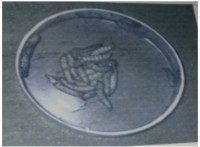Isolation of Entomopathogenic Nematode-Bacteria Complex with a Potential for Use as a Biological Insecticide in Nigeria
Keywords:
Galleria mellonella larvae, entomopathogenic nematode, SteinernemaAbstract
The larvae of G. mellonella obtained from honey combs were successfully grown to adult on newly developed artificial medium in the laboratory. Generations of the moth were grown and maintained on the artificial medium. The larvae were used as bait to trap entomopathogenic nematodes from the soil. The nematodes isolated were identified as Steinernema species based on their morphology. The pathogenicity of the nematodes is tested after storing them in water for three and six months respectively. It is observed that the ability of the nematodes to kill the larvae reduced with increase in the period of storage. Nematodes stored for six months killed only 20% of larvae treated while that stored for three months killed 40% of larvae treated. Death of the larvae occurred within 24 hours for freshly harvested infective juvenile nematodes while it took 72 hours for nematodes stored for three months and 168 hours (7days) for those stored for 6 months. The nematode-bacteria complex isolated has a potential for use as a biological insecticide.
References
Akhurst, R. J. (1982). Antibiotic activities of Xenorhabdus species bacteria symbiotically associated with insect pathogenic nematodes of the families Heterorhabditidae and Steinenermatidae. Journal of General Microbiology, 128, 3061-3065
Akhurst, R. J. and Boemare, N. E. (1990). Biology and taxonomy of Xenorhabdus. In: Gaugler, R. and Kaya, H.K. (Eds.), Entomopathogenic Nematodes in Biological Control. Boca Raton: CRC Press, FL, pp 75-87.
Aronson, A.I., Beckman, W. and Dunn, P. (1986). Bacillus thuringiensis and related insect pathogens. Microbiological reviews, 50, 1-24
Bedding, R. A., Akhurst, R. J. and Kaya, H. (1993). Nematodes and The Biological Control of Insect Pests. East Australia: CSIRO Publications. Pp.11-20
Burges, H. D. (1982). Control of insects by bacteria. Parasitology, 84, 79-117
Dewey, M. (1992). MAAREC Publication. American Bee Journal, 132, 647-649
Dix I., Burnell A.M., Griffin C.T. and Joyce S.A. (1992). The identification of biological species in the genus Hetrorhabditis (Nematoda: Heterorhabditidae) by cross-breeding second generation amphimictic adults. Parasitology, 104, 509-518
Ekaterina R., Lawrence L., Nuesa G. and Heather H. (2006). Control of The Oriental Fruit Moth, Grapholita molesta, Using Entomopathogenic Nematodes in Laboratory and Fruit Bin Assays. Journal of Nematology.
Fan, X. and Hominick, W.M. (1991). Efficiency of the Galleria (wax moth) baiting technique for recovering infective stages ofentomopathogenic rhabditids (Steinernematidae and Heterorhabditidae) from sand and soil. Review Nematologica, 14, 381-387
Gaugler, R. and Kaya, H.K. (1990). Entomopathogenic nematodes in Biological control. Boca Raton: CRC Press, Inc.,
FL. Grewal, P. S. and Peters, A. (2005). Formulation and quality. In: Grewal, P.S., Ehlers, R.U. and Shapiro-llan, D. (eds). Nematodes as Biocontrol Agents. Wallingford, UK: CABI Publishing; pp. 79-90
Kaya, H.K. and Stock, S.P. (1997). Techniques in insect Nematology. In: Lacey L.A (ed). Manual of Techniques in Insect Pathology, pp 281- 324. New York: Academic Press.
Knowles B. H., Blatt M. R., Tester M., Horsnell J. M., Carol J., Menestrina G. and Ellar D. J. (1989). A cytolytic _” endo-toxin from Bacillus thuringiensis var Isrealensis forms cation-selective Channels in planar lipid bilayers. FEBS Letters, 244, 259-262
Luc P.V., Nguyen K.B., Reid A.P. and Spiridonov S.E. (2000). Steinernema tami sp.n. (Rhabditida: Steinernematidae) from Cat Tien Forest, Vietnam. Russian Journal of nematology, 8, 33-43
Mahar, A.N., Munir, M. and Mahar, A.Q. (2004). Studies of different application methods for Xenorhabdus and Photorhabdus cells and their toxins in broth solution to control locust. Asian Journal of Plant Sciences, 3, 690-695
Molina-Ochoa J., Lezama-Gutierrez R., Hamm J.J., Wiseman B.R. and Lopez-Edwards M. (2000). Integrated Control of Fall Armyworm (Lepidoptera: Noctuidae) Using Resistant Plants and Entomopathogenic Nematodes (Rhabditidae: Steinernematidae). Florida Entomologist, 82, 263- 266
Morgan J.A.W., Kuntzelmann V., Tavemor S., Ousley M.A. and Winstanley C. (1997). Survival of Xenorhabdus nematophilus and Photorhabdus luminescence in water and soil. Journal of Applied Microbiology, 83, 665-670
Mracek, Z. (1980). The use of “Galleria traps” for obtaining nematodes parasites of insects in Czechoslovakia (Lepidotera: Nematoda, Steinernematidae). Acta Entomology Bohemoslov, 77, 378-382
Mracek, Z. and Becvar, S. (2000). Insect aggregations and entomopathogenic nematodes from the families Steinernematidae and Heterhabditidae (Nematode: Rhabditida) in the Czech Republic. Folia Parasitologica, 46, 145-148
Nguyen K. B., Malan A. P. and Gozel U. (2006). Steinernema Khoisanae n. sp. (Rhabditida: Steinernematidae) a new entomopathogenic nematode from South Africa. Nematology, 8, 157- 175
Owuama, C. I. (2001). Entomopathogenic symbiotic bacteria, Xenorhabdus and Photorhabdus of Nematodes. World Journal of Microbiology and Biotechnology, 17, 505-515
Poinar, G., O. Jr. (1990). Biology and Taxonomy of Steinernematidae and Heterorhabditidae. In: Gaugler, R. and Kaya, H.K. (Eds.), Entomopathogenic Nematodes in Biological Control. CRC Press, Boca Raton. FL. Pp. 23-62
Pinyon R. A., Hew F. H. and Thomas C. J. (2000). Xenorhabdus Boviennii T228 phase variation and virulence are independent of RecA function. Microbiology, 146, 2815-2824
Ribeiro C., Vignas M. and Brehelin M. (2003). Xenorhabdus nematophila (Enterobacteriacae) Secretes Cation-selective Calcium independent Porin Which Causes Vacuolation of the Rough Endoplasmic Reticulum and Cell Lysis. Journal of Biology and Chemistry, 278, 3030-3031
Sergeant M., Jarret M., Ousley M., Alun J. and Morgan W. (2003). Interactions of insecticidal Toxin Gene Products from Xenorhabdus nematophilus PMF 1296. Applied and Environmental Microbiology, 69, 3344-3349
Shapiro-llan, D. I. and Gaugler, R. (2002). Production Technology for Entomopathogenic Nematodes and Their Bacterial Symbionts. Journal of Industrial Microbiology and Biotechnology, 28: 137-146
White, G. F. (1927). A method for obtaining nematode larvae from Cultures. Science 66: 302-303
Williams, E. C. and Walters, K.F.A. (2000). Folia application of the Entomopathogenic Nematode, Steinernema feltiae against leafminers on Vegetables. Biocontrol Science and Technology, 10: 61-70

